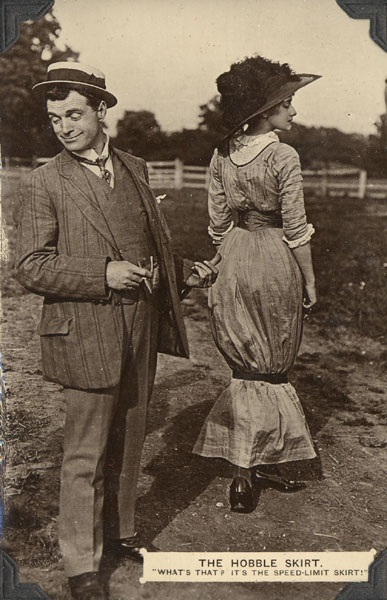Hesitation Canter Waltz
by John & Karen Herr
Historical Background
The Waltz is the undisputed “Queen of
the Ballroom” and is the dance most people think of by name first
when they think of “Ballroom Dancing.” Waltz originated in
Bavarian Europe in a form closest to what we now call Viennese Waltz.
The modern Slow Waltz was developed in the United States. Various
permutations on the waltz were developed in the United States
including:
a) Hesitation
Waltz (where one step was taken per measure),
b) Canter Waltz
(with two steps per measure), and
c) Boston Waltz
(one step per beat, at a much slower tempo).
The “Boston” was characterized by
long flowing steps, and the use of the closed dance position which
eventually became the Slow Waltz that it is today. The Slow Waltz was
then re-exported to Europe where it was a huge hit, especially in
Britain.
 In the USA, a derivation called Glide
Waltz was very popular in about the 1870’s, until the advent of the
Hesitation Waltz and ragtime music. The Hesitation Waltz gets its
name from the pause or hesitation in the music. The Hobble Skirt was
the dress of choice for the ladies to dance the “Hesitation” in
the early 1900’s (see photo). In the TV show “The Adams Family”,
Morticia wears what is called a “Black Gothic Hobble” dress. In the USA, a derivation called Glide
Waltz was very popular in about the 1870’s, until the advent of the
Hesitation Waltz and ragtime music. The Hesitation Waltz gets its
name from the pause or hesitation in the music. The Hobble Skirt was
the dress of choice for the ladies to dance the “Hesitation” in
the early 1900’s (see photo). In the TV show “The Adams Family”,
Morticia wears what is called a “Black Gothic Hobble” dress.
The ways of performing the “Hesitation”
are many and varied, and no single way can be said to be more
orthodox or correct than any other. Its popularity soared in the
1910s, and by 1913 was one of the main dances done by the exhibition
dance teams of the time.
Note: Hesitation was not limited to
Waltzes. It was, at one time, also used in Hesitation Tango, and
other rhythms.
Explanation/Description
Hesitation Canter Waltz is a
combination of the Hesitation Waltz and the Canter Waltz. The
Hesitation uses one step per measure. The Canter uses two steps per
measure.
In Hesitation, the dancer steps on beat
#1. In Canter, the dancer steps on beats #1 and #3. When combining
the two, completing 6 beats, and putting the Hesitation before the
Canter, we would be stepping on beats #1, #4, and #6. (If we were to
dance with a Canter followed by a Hesitation, then we would be
stepping on beats, #1, #3, and #4.)
We can now apply this pattern to our
commonly known figures like Maneuver, or 2 Left Turns, etc. For
example: Maneuver would take 6 beats, stepping on #1, #4, and #6. And
similarly, 2 Left Turns would take 12 beats using the same pattern,
and so on.
The speed of most of our Waltzes
(Boston) is about 30 MPMs (measures per minute). The speed of most
Hesitation/Canter/Hesitation-Canter is about 60 MPMs. Therefore,
performing 2 Left Turns in Hesitation/Canter (4 measures @ 60 MPMs),
or performing 2 Left Turns in Boston (2 measures @ 30 MPMs), the
results are that we are moving across the floor at about the same
speed, but with differences.
Two main differences of Hesitation
Canter over Boston:
a) We can now
dance to the 6/8 timing of musical pieces, and
b) The 1-4-6
pattern encourages sway naturally in many of the figures.
A related rhythm is Viennese Waltz
(which is also about 60 MPMs). When you listen to Hesitation Canter
vs. Viennese, look for the dreamier sounding music — perfect for
Hesitation Canter. The Viennese music makes you feel like stepping to
all three beats in each measure.
This is a new rhythm for Round Dancing.
Many people, at first, are not impressed, until they actually try it.
Then they fall in love with it. We hope that you enjoy it as much as
we do.
Tips for Teachers
1) Teaching the rhythm using the
pattern of 1-4-6 makes learning it VERY difficult. We recommend that
you avoid that. One idea is to begin your teach with a Slo-Qk-Qk
approach. Although this is not accurate, it is close enough to get
them into the rhythm. Of course the Slow is the first 3 beats, and
the Quicks pretty much end up close to beats 4 and 6. At some point,
teach them that the accurate execution of the rhythm is to step on
the 1-4-6 beats, and let them make the adjustment, as they are able.
2) Cueing and Cue Sheets: The full 6
beats is written in the Cue Sheet as a single measure (one
semi-colon). For example:
Canter 2x; 6
beats
Sway
Left/Right; 6 beats
2 Left
Turns;; 12 beats
Left Turning
Box;;;; 24 beats
So, you can see that it is very similar
to writing a regular [Boston] Waltz. In both, we cue Canter 2x for 6
beats of music, etc.
3) When we teach this rhythm, we start
off with “Canter Twice”. Next, we teach “Sway Left and Right”.
Then we combine them as: Canter 2x; Sway L/R; Canter 2x; Sway L/R; .
We finish this with:
Canter L-Hesitate;
(this is similar to a ‘Side Two Step Left’)
Canter R-Hesitate;
Canter-Hesitate
2x;;
Then we move on to dancing our normal
waltz figures like:
Twirl Vin 3; Pkup;
2 Left Turns;; Canter 2x; Sway L/R;
Twirl Vin 3;
Maneuver; 2 Right Turns;; Canter 2x; Sway L/R; etc.
4) Give them lots of practice with
these simple figures before tackling any Hesitation-Canter dance.
Good Luck and
Happy Canter-Hesitationing.
From
ROUNDALAB Journal, Fall 2010. Reprinted in the Dixie Round Dance Council (DRDC) Newsletter, May 2012. Visit John & Karen at Dancing Penguins.

|
